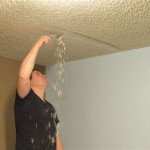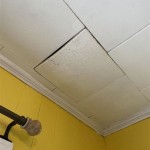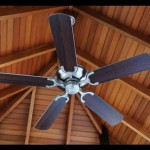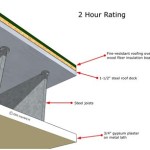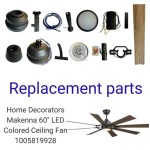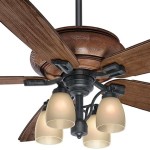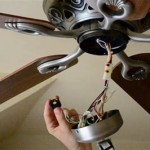Ceiling Fan With Light For Kitchen: Illumination and Air Circulation
The kitchen, often considered the heart of the home, is a space that demands a balance of functionality and comfort. Ensuring adequate lighting and ventilation is crucial for both safety and creating a pleasant environment for cooking, dining, and socializing. A ceiling fan with light offers a practical solution, combining effective air circulation with essential illumination, all within a single fixture. This article explores the advantages, considerations, and available options for integrating a ceiling fan with light into a kitchen space.
Optimizing Air Circulation and Climate Control
One of the primary benefits of a ceiling fan in the kitchen is its ability to circulate air. Kitchens, by their very nature, generate heat from cooking appliances such as ovens, stoves, and dishwashers. This heat can lead to stuffiness and discomfort, especially during warmer months. A ceiling fan combats this by moving air around the room, creating a cooling breeze that can significantly reduce the perceived temperature. The constant air movement also helps to dissipate humidity, preventing the build-up of condensation and reducing the risk of mold and mildew growth – a common concern in kitchens with frequent water usage.
Furthermore, ceiling fans can contribute to energy efficiency. By circulating air, they allow air conditioning systems to operate more effectively. The moving air provides a cooling sensation, enabling homeowners to raise the thermostat setting without sacrificing comfort. This can lead to substantial savings on energy bills, particularly during peak cooling seasons. In winter, many ceiling fans have a reverse direction setting that pulls cool air up from the floor and pushes warm air down from the ceiling, further distributing heat evenly throughout the room and reducing the strain on heating systems.
The strategic placement of a ceiling fan is essential to maximizing its effectiveness. In most kitchens, the center of the room is the ideal location, as this allows for even air distribution. The size of the fan should also be appropriate for the size of the kitchen. A smaller kitchen may only require a 42-inch fan, while a larger kitchen may benefit from a 52-inch or even a 60-inch fan. The height of the ceiling should also be considered, as fans should be mounted at least seven feet above the floor to ensure safety and optimal air circulation.
The blade pitch, or the angle of the fan blades, also plays a crucial role in air movement. Blades with a steeper pitch will move more air, but they may also be noisier. Conversely, blades with a shallower pitch will move less air but will operate more quietly. Selecting a fan with the appropriate blade pitch for the kitchen's specific needs is important for achieving the desired balance between airflow and noise level. Modern ceiling fans often incorporate aerodynamic blade designs that optimize air movement while minimizing noise.
The motor of the ceiling fan is another critical factor to consider. Energy-efficient motors, such as DC motors, consume significantly less electricity than traditional AC motors. DC motors are also typically quieter and offer more speed settings, allowing for finer control over airflow. While DC motor fans may have a higher initial cost, the long-term energy savings can offset this expense.
Providing Essential Illumination for Kitchen Tasks
Beyond air circulation, a ceiling fan with light provides essential illumination for kitchen tasks. Adequate lighting is crucial for food preparation, cooking, and cleaning. Poor lighting can lead to accidents and errors, while insufficient light can strain the eyes and make it difficult to perform tasks with precision. A ceiling fan with light offers a centralized source of illumination that can supplement existing kitchen lighting, ensuring that the entire space is adequately lit.
The type of lighting incorporated into the ceiling fan can significantly impact the kitchen's ambiance and functionality. Traditional incandescent bulbs are inefficient and produce a warm, yellowish light. Halogen bulbs are brighter and more energy-efficient than incandescent bulbs, but they still produce a significant amount of heat. LED (light-emitting diode) bulbs are the most energy-efficient and long-lasting option. They also produce a variety of light colors, allowing homeowners to customize the kitchen's lighting to suit their preferences.
The brightness of the lighting, measured in lumens, should be appropriate for the size and function of the kitchen. A larger kitchen will require more lumens than a smaller kitchen. Task lighting, such as under-cabinet lighting, should also be considered to provide focused illumination for specific work areas. A dimmable ceiling fan with light allows homeowners to adjust the brightness to suit different tasks and moods, creating a more versatile and comfortable environment.
The design of the light fixture can also impact the overall aesthetic of the kitchen. Ceiling fans with lights are available in a wide variety of styles, from traditional to contemporary. The style of the fan should complement the kitchen's existing décor. For example, a kitchen with a farmhouse theme might benefit from a ceiling fan with a rustic design, while a modern kitchen might be better suited to a sleek, minimalist fan. The finish of the fan, such as brushed nickel, oil-rubbed bronze, or white, should also coordinate with the kitchen's other fixtures and appliances.
The color temperature of the light is another important consideration. Color temperature is measured in Kelvin (K). Warm white light (2700-3000K) creates a cozy and inviting atmosphere, while cool white light (4000-5000K) is brighter and more energizing. Daylight (6000-6500K) is the closest to natural sunlight and is ideal for tasks that require high levels of detail. The appropriate color temperature for a kitchen depends on the homeowner's preferences and the overall design of the space.
Selecting the Right Ceiling Fan with Light for Your Kitchen
Choosing the right ceiling fan with light for a kitchen requires careful consideration of several factors, including size, style, functionality, and budget. Before making a purchase, it is essential to measure the kitchen's dimensions, including the ceiling height and floor area. This will help determine the appropriate size of the fan and ensure that it is mounted at a safe and effective height.
The style of the fan should complement the kitchen's overall décor. Consider the existing color scheme, cabinetry style, and appliance finishes when selecting a fan. There are numerous designs available, ranging from traditional to contemporary, and a wide variety of finishes to choose from. Look for a fan that enhances the kitchen's aesthetic appeal while providing the necessary functionality.
Functionality is another crucial consideration. Determine the desired level of airflow and illumination. Look for a fan with multiple speed settings and a dimmable light fixture. Consider the type of lighting desired, such as LED, halogen, or incandescent, and choose a fan that accommodates the preferred bulb type. Energy efficiency is also important, so look for a fan with an energy-efficient motor and light fixture.
The control options for the fan and light should also be considered. Some fans come with pull chains, while others have remote controls or wall controls. Remote controls offer the convenience of adjusting the fan speed and light brightness from anywhere in the room. Wall controls provide a more permanent and accessible option. Some fans can even be integrated with smart home systems, allowing for control via smartphone or voice assistant.
Finally, consider the budget. Ceiling fans with lights range in price from relatively inexpensive to quite expensive. Set a budget before shopping and stick to it. Consider the long-term costs of operating the fan, including energy consumption and bulb replacement. A more expensive fan with an energy-efficient motor and long-lasting LED bulbs may ultimately be more cost-effective than a cheaper fan with a less efficient design.
Installation is a crucial step in ensuring the safe and effective operation of the ceiling fan. It is recommended to hire a qualified electrician to install the fan, especially if the wiring is complex or if the homeowner is not comfortable working with electricity. Proper installation will ensure that the fan is securely mounted and that the wiring is correctly connected. Following the manufacturer's instructions carefully is essential for a safe and successful installation.
In conclusion, selecting a ceiling fan with light for the kitchen involves a comprehensive evaluation of factors, including air circulation needs, lighting requirements, stylistic preferences, and budget constraints. By carefully considering these aspects, homeowners can choose a fixture that enhances the functionality and aesthetics of their kitchen, creating a more comfortable and enjoyable space.

Dinglilighting Ceiling Fan With Light 42 Vintage Acrylic Chandelier Fixtures Remote Retractable Blades For Living Room Kitchen Bedroom 5 E26 Base Walmart Com

Antoine 36 In Indoor Black Ceiling Fan With Lights And Remote Retractable Blades Fandelier Hd 2 22 The Home

Best Ceiling Fans For Kitchens Ultimate Buying Guide Advanced Systems Fan In Kitchen

Matching Ceiling Fan And Lighting Fixtures For 2024 Spring Hunter

Depuley 26 Ceiling Fan With Lights And Remote Light Modern Flush Mount Farmhouse Fans For Kitchen Bedroom Dining Room 3 Speeds Adjustable 6 E26 Bulb Base Black Walmart Com

Shop Ceiling Fan Tips Lightstyle Of Tampa Bay

Blossom Kitchen Ceiling Fan Lighting Traditional Frosted Glass 3 Lights Gold Semi Flush Light Clearhalo

Here S What You Need From A Kitchen Ceiling Fan Decorology

Pendant Lighting Gives This Modern Kitchen A New Twist Ceiling Fan In Interiors

Farmhouse Ceiling Fans With Lights Wood Flush Mount Fan Remote Control Caged Indoor Light For Living Room Bedroom Kitchen Yahoo Shopping

